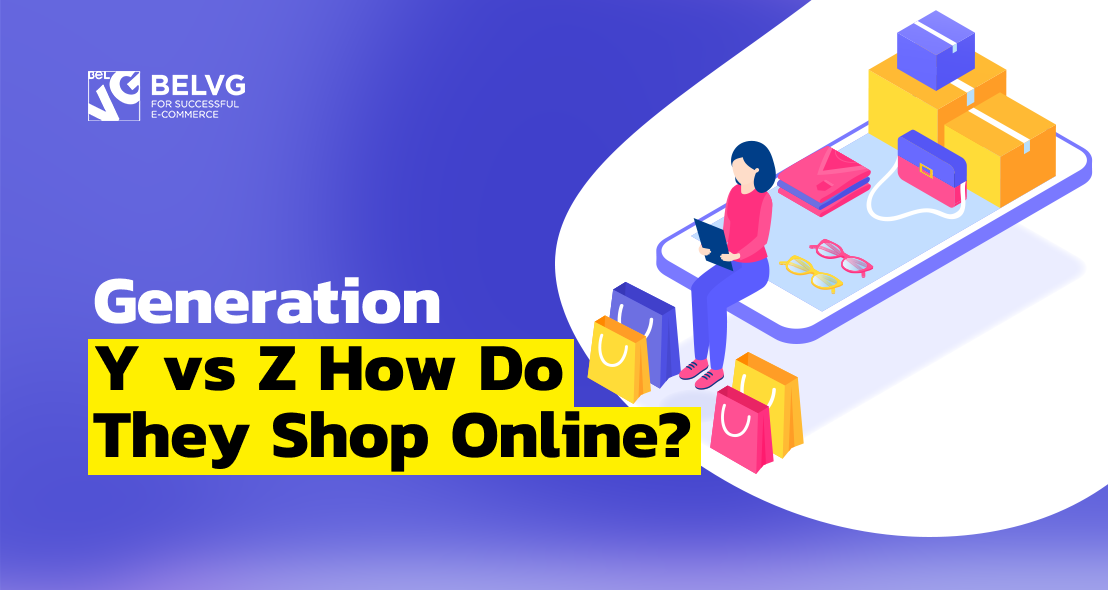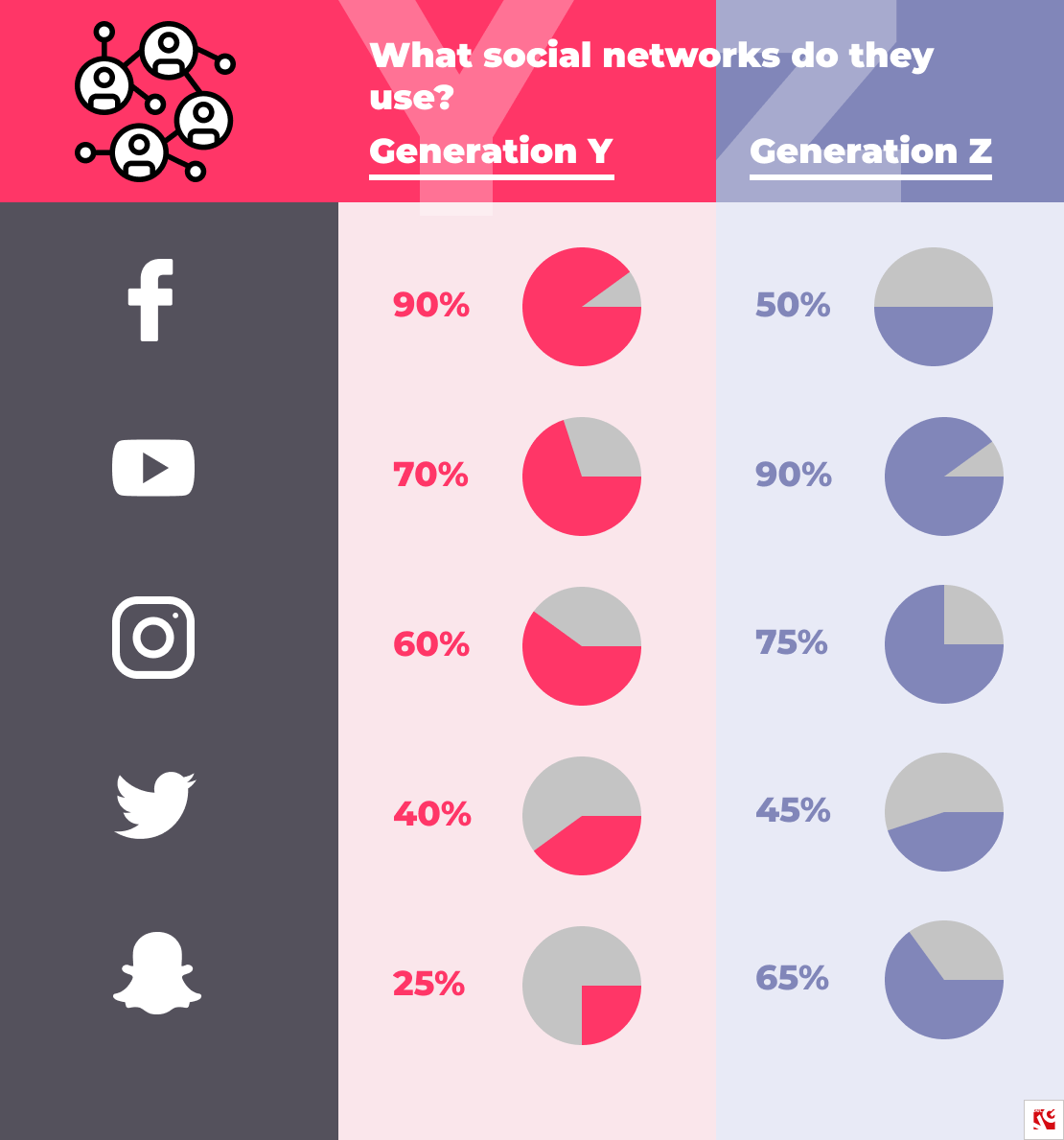
Have you ever wondered who are your customers? How old are they? How do the shopping habits vary among age and generations? In this article, we will define Generation Y and Z, and you will learn how to adjust your marketing tactics to target two biggest generation groups – Millennials and Post-Millenials.
Table of contents:
What do we know about Generation Y?
What do we know about Generation Z?
What about Generation Z vs Y personal qualities?
How does Generation Y & Z difference influence online shopping?
How to win generations over?
Who will be next?
What do we know about Generation Y?
Nowadays, Generation Y makes up the workforce majority worldwide and comprises around a quarter of the global population. There are several different views on who to call Millennials. Some researchers think that these are the people who were born between 1980 and 1994, but another smaller group argues that the time frame is 1982 to 2004 [1].
Facebook, Instagram, YouTube, and Twitter appeared in the 21st century and became the main fellows of the Millennials in the US in their professional and social life. Together with the significant historical events of the 21st century, they caused a substantial change in the way Millennials think and behave. Gen Y is that very generation that watched the dawn break over data tsunami that hit the humankind with the internet appearance. To date, Millennials represent the most educated population group.
One of the most distinct Millennial habits is a constant connection. Most of the Millennials can hardly remember a time when they were not connected to the web 24/7. Sharing their feelings and thoughts on social media on a daily basis, these digital pioneers cannot live without posting online. Due to the regular use of multiple social media accounts, and text messages, Gen Y is also characterized by shorter memory spans compared to the previous generations. They are also known as the first clip thinking generation. They have obtained the habit of perceiving information in short fragments of narrative and struggling when faced with more extended, more complex ideas.
Since now the Gen Y representatives are approximately 25-39 years old, many of them are about to start paying off their student debts. Once they come closer to that, the luxurious wedding expenses come into play. In most cases, financial instability pushes Millennials to choose access over ownership.
What do we know about Generation Z?
In case you were wondering what generation comes after Millennials, the answer is right here. It is Generation Z, people who were born between 1995 and 2010. Another group of researchers consider people born between 2004 and 2018 Post-millennials. Now, they are the largest generation that has ever existed as in 2019 it makes up around 32% of the global population [2].
The average representative of this generation receives the first mobile phone at the age of 10, and Post-millennials are likely to grow playing with mobile phones and tablets of their parents. As you have guessed, it has a significant impact on their personalities. Gen Z was born in an age of rapid innovations, and their expectations from technologies and stuff they purchase are really high. Today, the features like Advanced Face ID, retina screen, LCD and 4K videos are perceived not as wonders, but instead are taken for granted. On average, Gen Z spends at least 3 hours a day on their mobile devices.
As a matter of fact, if we do not take into account the infants and toddlers, Gen Z consists of the youngest people on the planet. As soon as this generation members mature into the adolescent identities, their personalities are likely to morph, and yet, it is hard to predict how.
What about Generation Z vs Y personal qualities?
95% of Millennials still spend a lot of their time watching TV, but they already tend to choose Netflix over the traditional cable providers. It has become the first generation to feel entirely comfortable with mobile devices and tablets. On the other hand, 32% of Millennials will still use a computer if they want to make a purchase online.
Millennials were born and raised during the economic boom, and tend to be optimistic, trusting, and work collaboratively. While Gen Z, on the other hand, grew up in the time of recession, and this economic pressure shaped them to be more pragmatic. This generation possesses a much higher awareness of global problems than the previous generations. Approximately 60% of Post-millennials claim that they want to change the world compared to 39% of Millennials.
Being present during the financial struggle of their parents and the whole community, Generation Z learns about personal finance much earlier than their parents and grandparents. They have adopted a more fiscally conservative approach and will try to avoid debts, by all means, using debit cards and mobile banking over the credit cards.
Generation Y has become digital pioneers, while Generation Z is already digitally native. Born and raised in the hyper-connected world, Post-millennials are generally independent, sceptic and hold to more realistic views than Gen Y and the ones before it. For Post-millennials technologies are not the modern Wonder of the World, and most of them take progress for granted not being amused by top-notch devices. While Millennials strongly prefer digital communication, Generation Z will choose for face-to-face communication when possible [3].
How does Generation Y & Z difference influence online shopping?
It may seem unusual, but having no significant age difference, Generation Y and Z are distinct from each other in how they shop, what they purchase, and in the way they view their money.
It is an interesting fact that in comparison with Gen Y, Gen Z prefers shopping in stores over online shopping [4]. They find it important to feel and see products for real to ensure the high quality, and they also seek the experiences that happen in stores. On the other hand, Millennials are obsessed with online shopping. Some of them still remember the world without 24/7 connection, and they tend to take advantage of internet convenience every single time. Data from the Numerator InfoScout OmniPanel consumer panel of more than 500,000 U.S. shoppers reveals that Millennials see more value in online shopping than Gen Z. It also shows that the online channel captures 10.4% of Gen Y spend, compared to 7.4% of Gen Z spend.
Millennials have higher expectations for customer experience, and 75% of them will pay more for it compared to 69% of Gen Z. As it was mentioned before, Post-millennials possess higher personal finance awareness than previous generations [5]. Today’s teenagers are more interested in saving money than Millennials were at that age. Gen Z is attracted to purchases that maximize the value of every dollar and highly prefers cool products over cool experiences. The possible reason is that products may seem something long-lasting, and experiences are temporary and do not possess financial value.
Post-millennials are less likely to plan their purchases. Shopping lists are popular among 59% of Millennials and 51% of Gen Z. It means that they may be more receptive to offers designed to prompt impulse buying. But on the other hand, realistic views make it less likely that Post-millennial will get hooked by some advertisement. They are much better in self-directed research looking for information mostly on social media or YouTube.
When Millennials were teenagers, it was the brand name frenzy time. Fashion sense could be shown only by wearing t-shirts, jeans, and shoes from the hottest brands. Now since they have become adults, and their purchasing power increased, Millennials are able to pay more for their favorite brands. Gen Z, on the other hand, doesn’t want to be defined by any brand other than their own. Independence is their priority. However, both generations show less trust in brands than previous generations. The sign of independence we can also see in the fact that according to Salesforce Research, over 55% of Millennials do not mind companies using their data, but only 44% of Gen Z agree.
We have seen that Millennials like authenticity, but Post-millennials took it to a genuinely new level, they are way more obsessed with finding brands that feel authentic. They deeply respect the brands that reject using PhotoShop in their catalogs and marketing campaigns. Gen Z wants to see not overly polished content.
With every new generation, the attention span gets shorter, which is a bad sign for the marketers. Targeted with thousands of ads a day, on average the Generation Z members pay attention to the ads for maximum 8 seconds, while their predecessors do that for 12 seconds.
How to win Millennials and Post-millennials over?
The oldest Millennials by now are 39 years old, while the oldest Post-millennials are 24. As you can see, these two largest generations are the most prominent customer groups of most of the online stores, so for every merchant, winning them over is the task of great importance.
The following ecommerce tips are foreground:
- Mobile first. If your website is not mobile-responsive, in the eyes of Gen Z and Y, your brand does not exist. It’s just that simple.
- Use social media, and make a difference, while Gen Y members check the public opinion on the product on Facebook and Google, Gen Z tends to use Snapchat and Instagram [6]. Increase your social presence to make them notice you, and involve social media influencers to promote your profile.
- Don’t get fooled by the youthful looks; Generation Z is not kids anymore. Their purchasing power has already exceeded $143 billion. Don’t you agree that this number is to be taken seriously? Millennials are also not teenagers, as some might still think. They are adults who are going to become the wealthiest generation that has ever existed once they inherit from their parents.
- Take into account your customer preferences. While Generation Z is likely to choose a cool product over a cool experience, Generation Y chooses cool experiences over cool products. Gen Z is more materialistic. They seek to become the owners of unique stuff that their neighbors or friends don’t have.
- Understand the difference in the way Gen Z and Y choose the products to purchase. Millennials tend to read the reviews and comments, look through the discussions about the product if there are any. Post-millennials, on the other hand, are attracted by interactive product presentation. They seek shows in any product they buy. There are no marketing means that would work out better with Gen Z than proper show. Doubt it? Just think about Gucci marketing campaign. Released by a famous American rapper Lil Pump in 2017, the song Gucci Gang is heading towards 1 billion views on YouTube. With its help, Gucci has targeted young people, and according to Google Trends data, searches for Gucci went sky-high with the clip release.
- Use different advertising techniques. The advertisements that deliver emotions like the ones with kids, cats, and dogs, successfully capture the eye of Millennials. We can already see this tactic being used by such brands as Mercedes, Target, and Subaru [7]. Mercedes actively uses dogs as well as other animals like elephants and deer in their advertisements. Already for a while, Target uses a white bull-terrier with the red target around the eye as their mascot. Subaru advertises its cars as “dog tested.” No one can deny that Gen Z is not the target audience of these companies; their main customers are Millennials. Generation Z is more likely to get interested when they see some celebrity, musician, or a famous athlete. 29% of Gen Z claims that celebrity endorsement influences their purchases [8].
- Understand your consumer persona. You need to realize that the customers might have different interests even within a single product category. For example, Gen Z concerns themselves with sport, and Gen Y wonders fitness. Basically, it means that Post-millennial is likely to buy some unique sport shoes, and Millennial will go for Nordic walking poles. Defining your customer, you need to hit the aim.
- Use video content — a lot of it. Clip thinking has become a reality with Gen Y and kept flourishing among Gen Z members. Both of them simply cannot live without videos. Also, there is a small but influential detail – you need to keep an eye on video duration. As we mentioned earlier, the average advertising attention span of Gen Y is 12 seconds, and Gen Z has it even shorter — 8 seconds. Make sure to get to the main point faster and keep the intro short.

Facebook All in One for Magento 2
Connect your online store to the world's most powerful social network.
Learn moreWho will be next?
Generation Z is succeeded by Generation Alpha — children, born between 2010 and 2025. Kids of the tech-savvy optimistic Millennials and born-online sceptic Post-millennials, they are expected to become the generation with the best formal education and technological supply. Besides that, Generation Alpha is going to influence the family budget allocation and large purchases more than any kids or teenagers of the past.
Generation Alpha is not content with only Barbies and Lego – they demand gadgets. There is already a rising number of YouTube influencers among Generation Alpha kids. Most of the parents are familiar with Ryan’s Toys Review channel, that has over 20 million active subscribers. According to Forbes, Ryan is currently the highest-paid YouTube star, which is quite an achievement for a 7-year-old boy. Other big names are Mila and Emma Stauffer. The girls have over 4 million followers on Instagram. 8-year-old Coco Pink Princess is a fashion kid influencer who has already featured in her Instagram account clothes and accessories from such brands as Gucci and Burberry.
They are not only advertising toys, games and children’s clothes from famous brands anymore. More and more kid influencers create toy and clothing lines. 4-year-old Millie-Belle Diamond even appeared on the New York Fashion Week. Their impact on the economy is slowly but steadily recognized. As a result, some brands take the course on establishing long-term relationships with their customers from an early age.
As you can see, the new generation of influencers is on the rise. Even though there is still quite some time until they grow up, it is safer to research your audience and get your marketing strategies prepared from early on.
Conclusion
Wrapping it up, we can say that in 2019 Millennials and Post-Millennials having over $600 billion in purchasing power combined have become the core consumer focus for a great majority of retailers. These two generations are the main customers in the sphere of ecommerce. At the same time, it is essential to keep in mind their differences. They cannot be mixed and taken as one target group even though they are close in age. Both of them possess distinct features that any marketer should take into account to win their hearts.
Furthermore, age is not the only indicator to segment your audience. Gender has a great influence on shopping habits as well. Find out more about how men and women shop online in our article.
Who are your customers? How do you segment your online store audience? Share your experience in the comments section below.
[1]Generation Y: a guide to a much-maligned demographic, by Kate Lyons, the Guardian, from 2016.
[2] Gen Z Is Set to Outnumber Millennials Within a Year, by Lee J Miller and Wei Lu, Bloomberg, from 2018.
[3] Everything you need to know about Generation Z, by Sharon Florentine, CIO, from 2018.
[4] Millennials Tried to Kill the American Mall, But Gen Z Might Save It, by Jordyn Holman, Bloomberg, from 2019.
[5] In Regions Hit by Recession, Gen Z Is Turning Out to Be Frugal, by Lisa Du and Ellen Milligan, Bloomberg, from 2019.
[6] CNN Business exclusive: Snapchat is betting on this former Amazon exec to go after Gen Z users, by Kaya Yurieff, from 2019.
[7] Pet Pampering Surges as Millennials Practice Parenting, by Adrianne Pasquarelli, AdAge, from 2018.
[8] How Celebs and Brands Can Get in the Game with Gen Z, Nielsen, from 2017.









Please, make another article about Gen X vs Gen Y